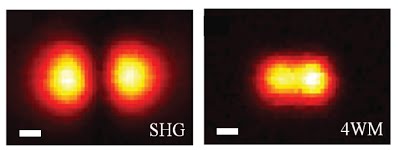Plasmonics
The optical responses of metal nanoparticles are governed by the collective oscillation of their surface electrons, called plasmons. When light interacts with these plasmon resonances, it creates highly confined electromagnetic fields with volumes much smaller than the diffraction limit of free space light beams. We utilize these fields to enhance and manipulate the light-matter interaction at the nanoscale. We use nanofabrication techniques to create metal nanosystems that have a desired geometry which in turn tailors their optical properties such as color, photonic density of states, ultrafast optical response etc. These plasmonic nanosystems can be used to enhance the performance of nanoscale emitters or photodetectors. They can also be used as building blocks for optical metamaterials and metasurfaces: artificial macroscopic objects with engineered optical response.
The image below shows a scanning electron micrograph of a plasmonic system (dipole optical antenna) made of 2 gold nanorods (left), and spectra of metal nanoparticles of different sizes showing the plasmonic resonance (right).

Nonlinear Optics at Nanoscale
The interaction of light with matter is generally described by the exciting electric field E and its induced polarization P
P = εχ(1)E + χ(2)EE + χ(3)EEE + . . . (1)
Most of the optical phenomena are described by the first term in this equation when the relationship between the excitation field and the polarization currents is linear. However, for strong excitation fields this linear relationship breaks down and higher order terms in Eq. 1 come into play. This leads to emergence of new phenomena that can be utilized for frequency conversion, modulation, and switching. Thus, the nonlinearity is an additional “knob” that allows us to tune the light matter interaction. In nanoscale materials, the nonlinear response is not governed only by χ(i) tensor elements but also by the geometry of the system which gives us even further tunabilty.
The example below shows signal generation of two different nonlinear processes on a plasmonic dimer system. The same nanoparticle can generate different spatial distributions of the signal for second harmonic generation (second order nonlinear process) and four wave mixing (third order nonlinear process). Scalebar is 100 nm.

Nanomaterials
Properties of materials are usually determined by their structure. For example, if an object is made out of gold it has certain yellowish color. However, the foundation of nanoscience is to try to alter these properties of the materials by changing their size and shape.
Graphene Photonics
Recent Comments